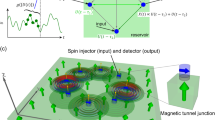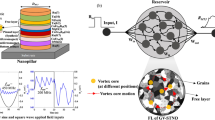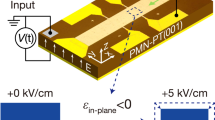Abstract
Strongly interacting artificial spin systems are moving beyond mimicking naturally occurring materials to emerge as versatile functional platforms, from reconfigurable magnonics to neuromorphic computing. Typically, artificial spin systems comprise nanomagnets with a single magnetization texture: collinear macrospins or chiral vortices. By tuning nanoarray dimensions we have achieved macrospin–vortex bistability and demonstrated a four-state metamaterial spin system, the ‘artificial spin-vortex ice’ (ASVI). ASVI can host Ising-like macrospins with strong ice-like vertex interactions and weakly coupled vortices with low stray dipolar field. Vortices and macrospins exhibit starkly differing spin-wave spectra with analogue mode amplitude control and mode frequency shifts of Δf = 3.8 GHz. The enhanced bitextural microstate space gives rise to emergent physical memory phenomena, with ratchet-like vortex injection and history-dependent non-linear fading memory when driven through global magnetic field cycles. We employed spin-wave microstate fingerprinting for rapid, scalable readout of vortex and macrospin populations, and leveraged this for spin-wave reservoir computation. ASVI performs non-linear mapping transformations of diverse input and target signals in addition to chaotic time-series forecasting.
This is a preview of subscription content, access via your institution
Access options
Access Nature and 54 other Nature Portfolio journals
Get Nature+, our best-value online-access subscription
$29.99 / 30 days
cancel any time
Subscribe to this journal
Receive 12 print issues and online access
$259.00 per year
only $21.58 per issue
Buy this article
- Purchase on Springer Link
- Instant access to full article PDF
Prices may be subject to local taxes which are calculated during checkout





Similar content being viewed by others
Data availability
The datasets generated and/or analysed during the current study are available from the corresponding author upon reasonable request.
Code availability
The code used in this study is available from the corresponding author upon reasonable request.
References
Skjærvø, S. H., Marrows, C. H., Stamps, R. L. & Heyderman, L. J. Advances in artificial spin ice. Nat. Rev. Phys. 2, 13–28 (2020).
Wang, R. et al. Artificial ‘spin ice’ in a geometrically frustrated lattice of nanoscale ferromagnetic islands. Nature 439, 303–306 (2006).
Shinjo, T., Okuno, T., Hassdorf, R., Shigeto, K. & Ono, T. Magnetic vortex core observation in circular dots of permalloy. Science 289, 930–932 (2000).
Ladak, S., Read, D., Perkins, G., Cohen, L. & Branford, W. Direct observation of magnetic monopole defects in an artificial spin-ice system. Nat. Phys. 6, 359–363 (2010).
Morgan, J. P., Stein, A., Langridge, S. & Marrows, C. H. Thermal ground-state ordering and elementary excitations in artificial magnetic square ice. Nat. Phys. 7, 75–79 (2011).
Yu, H., Xiao, J. & Schultheiss, H. Magnetic texture based magnonics. Phys. Rep. 905, 1–59 (2021).
Sklenar, J. et al. Field-induced phase coexistence in an artificial spin ice. Nat. Phys. 15, 191–195 (2019).
Louis, D. et al. A tunable magnetic metamaterial based on the dipolar four-state Potts model. Nat. Mater. 17, 1076–1080 (2018).
Grundler, D. Reconfigurable magnonics heats up. Nat. Phys. 11, 438–441 (2015).
Chumak, A., Serga, A. & Hillebrands, B. Magnonic crystals for data processing. J. Phys. D 50, 244001 (2017).
Barman, A., Mondal, S., Sahoo, S. & De, A. Magnetization dynamics of nanoscale magnetic materials: a perspective. J. Appl. Phys. 128, 170901 (2020).
Kaffash, M. T., Lendinez, S. & Jungfleisch, M. B. Nanomagnonics with artificial spin ice. Phys. Lett. A 402, 127364 (2021).
Barman, A. et al. The 2021 magnonics roadmap. J. Phys. Condens. Matter 33, 413001 (2021).
Papp, Á., Porod, W. & Csaba, G. Nanoscale neural network using non-linear spin-wave interference. Nat. Commun. 12, 6422 (2021).
Dion, T. et al. Observation and control of collective spin-wave mode-hybridisation in chevron arrays and square, staircase and brickwork artificial spin ices. Phys. Rev. Res. 4, 013107 (2022).
Arroo, D. M., Gartside, J. C. & Branford, W. R. Sculpting the spin-wave response of artificial spin ice via microstate selection. Phys. Rev. B 100, 214425 (2019).
Dion, T. et al. Tunable magnetization dynamics in artificial spin ice via shape anisotropy modification. Phys. Rev. B 100, 054433 (2019).
Stenning, K. D. et al. Magnonic bending, phase shifting and interferometry in a 2D reconfigurable nanodisk crystal. ACS Nano 15, 674–685 (2020).
Vanstone, A. et al. Spectral-fingerprinting: microstate readout via remanence ferromagnetic resonance in artificial spin systems. Preprint at https://arXiv.org/abs/2106.04406 (2021).
Chaurasiya, A. K. et al. Comparison of spin-wave modes in connected and disconnected artificial spin ice nanostructures using Brillouin light scattering spectroscopy. ACS Nano 15, 11734–11742 (2021).
Lendinez, S., Kaffash, M. T. & Jungfleisch, M. B. Emergent spin dynamics enabled by lattice interactions in a bicomponent artificial spin ice. Nano Lett. 21, 1921–1927 (2021).
Keim, N. C., Paulsen, J. D., Zeravcic, Z., Sastry, S. & Nagel, S. R. Memory formation in matter. Rev. Mod. Phys. 91, 035002 (2019).
Tanaka, G. et al. Recent advances in physical reservoir computing: a review. Neural Netw. 115, 100–123 (2019).
Nakajima, K. Physical reservoir computing—an introductory perspective. Jpn. J. Appl. Phys. 59, 060501 (2020).
Marković, D., Mizrahi, A., Querlioz, D. & Grollier, J. Physics for neuromorphic computing. Nat. Rev. Phys. 2, 499–510 (2020).
Milano, G. et al. In materia reservoir computing with a fully memristive architecture based on self-organizing nanowire networks. Nat. Mater. 21, 195–202 (2022).
Chumak, A. et al. Roadmap on spin-wave computing. IEEE Trans. Magn. https://doi.org/10.1109/TMAG.2022.3149664 (2022).
Dawidek, R. W. et al. Dynamically driven emergence in a nanomagnetic system. Adv. Funct. Mater. 31, 2008389 (2021).
Torrejon, J. et al. Neuromorphic computing with nanoscale spintronic oscillators. Nature 547, 428–431 (2017).
Nakane, R., Tanaka, G. & Hirose, A. Reservoir computing with spin waves excited in a garnet film. IEEE Access 6, 4462–4469 (2018).
Hon, K. et al. Numerical simulation of artificial spin ice for reservoir computing. Appl. Phys. Express 14, 033001 (2021).
Jensen, J. H., Folven, E. & Tufte, G. Computation in artificial spin ice. In ALIFE 2018: The 2018 Conference on Artificial Life, 15–22 (MIT Press, 2018).
Jensen, J. H. & Tufte, G. Reservoir computing in artificial spin ice. In ALIFE 2020: The 2020 Conference on Artificial Life, 376–383 (MIT Press, 2020).
Welbourne, A. et al. Voltage-controlled superparamagnetic ensembles for low-power reservoir computing. Appl. Phys. Lett. 118, 202402 (2021).
Yildiz, I. B., Jaeger, H. & Kiebel, S. J. Re-visiting the echo state property. Neural Netw. 35, 1–9 (2012).
Moon, J. et al. Temporal data classification and forecasting using a memristor-based reservoir computing system. Nat. Electron. 2, 480–487 (2019).
Gartside, J. C. et al. Reconfigurable magnonic mode-hybridisation and spectral control in a bicomponent artificial spin ice. Nat. Commun. 12, 2488 (2021).
Metlov, K. L. & Guslienko, K. Y. Stability of magnetic vortex in soft magnetic nano-sized circular cylinder. J. Magn. Magn. Mater. 242, 1015–1017 (2002).
Guslienko, K. Y. Magnetic vortex state stability, reversal and dynamics in restricted geometries. J. Nanosci. Nanotechnol. 8, 2745–2760 (2008).
Talapatra, A., Singh, N. & Adeyeye, A. Magnetic tunability of permalloy artificial spin ice structures. Phys. Rev. Appl. 13, 014034 (2020).
Gartside, J. C., Burn, D. M., Cohen, L. F. & Branford, W. R. A novel method for the injection and manipulation of magnetic charge states in nanostructures. Sci. Rep. 6, 32864 (2016).
Nisoli, C. et al. Ground state lost but degeneracy found: the effective thermodynamics of artificial spin ice. Phys. Rev. Lett. 98, 217203 (2007).
Kittel, C. On the theory of ferromagnetic resonance absorption. Phys. Rev. 73, 155–161 (1948).
Jungfleisch, M. et al. Dynamic response of an artificial square spin ice. Phys. Rev. B 93, 100401 (2016).
Gartside, J. C. et al. Realization of ground state in artificial kagome spin ice via topological defect-driven magnetic writing. Nat. Nanotechnol. 13, 53–58 (2018).
Wang, Y.-L. et al. Rewritable artificial magnetic charge ice. Science 352, 962–966 (2016).
Chou, K. et al. Direct observation of the vortex core magnetization and its dynamics. Appl. Phys. Lett. 90, 202505 (2007).
Barman, A., Barman, S., Kimura, T., Fukuma, Y. & Otani, Y. Gyration mode splitting in magnetostatically coupled magnetic vortices in an array. J. Phys. D 43, 422001 (2010).
Schultheiss, K. et al. Excitation of whispering gallery magnons in a magnetic vortex. Phys. Rev. Lett. 122, 097202 (2019).
Jaeger, H. The “echo state” approach to analysing and training recurrent neural networks – with an erratum note (Fraunhofer Institute for Autonomous Intelligent Systems, 2010).
Lukoševičius, M. & Jaeger, H. Reservoir computing approaches to recurrent neural network training. Comput. Sci. Rev. 3, 127–149 (2009).
Atiya, A. F. & Parlos, A. G. New results on recurrent network training: unifying the algorithms and accelerating convergence. IEEE Trans. Neural Netw. 11, 697–709 (2000).
Du, C. et al. Reservoir computing using dynamic memristors for temporal information processing. Nat. Commun. 8, 2204 (2017).
Wang, Z. et al. Resistive switching materials for information processing. Nat. Rev. Mater. 5, 173–195 (2020).
Burn, D., Chadha, M. & Branford, W. Dynamic dependence to domain wall propagation through artificial spin ice. Phys. Rev. B 95, 104417 (2017).
Pushp, A. et al. Domain wall trajectory determined by its fractional topological edge defects. Nat. Phys. 9, 505–511 (2013).
Gartside, J. C. et al. Current-controlled nanomagnetic writing for reconfigurable magnonic crystals. Commun. Phys. 3, 219 (2020).
Pancaldi, M., Leo, N. & Vavassori, P. Selective and fast plasmon-assisted photo-heating of nanomagnets. Nanoscale 11, 7656–7666 (2019).
Gypens, P., Leo, N., Menniti, M., Vavassori, P. & Leliaert, J. Thermoplasmonic nanomagnetic logic gates. Preprint at https://arXiv.org/abs/2110.14212 (2021).
Stenning, K. D. et al. Low power continuous-wave all-optical magnetic switching in ferromagnetic nanoarrays. Preprint at https://arXiv.org/abs/2112.00697 (2021).
Bhat, V. et al. Magnon modes of microstates and microwave-induced avalanche in kagome artificial spin ice with topological defects. Phys. Rev. Lett. 125, 117208 (2020).
Caravelli, F., Chern, G.-W. & Nisoli, C. Artificial spin ice phase-change memory resistors. New J. Phys. 24, 023020 (2022).
Caravelli, F., Iacocca, E., Chern, G.-W., Nisoli, C. & de Araujo, C. I. Anisotropic magnetomemristance. Preprint at https://arXiv.org/abs/2109.05101 (2021).
Vansteenkiste, A. & Van de Wiele, B. MuMax: a new high-performance micromagnetic simulation tool. J. Magn. Magn. Mater. 323, 2585–2591 (2011).
Vansteenkiste, A. et al. The design and verification of MuMax3. AIP Adv. 4, 107133 (2014).
Stancil, D. D. & Prabhakar, A. Spin Waves 5 (Springer, 2009).
Acknowledgements
W.R.B. and J.C.G. were supported by the Leverhulme Trust (RPG-2017-257 to W.R.B.). A.V. was supported by the EPSRC Centre for Doctoral Training in Advanced Characterisation of Materials (grant no. EP/L015277/1). T.D. was supported through a International Research Fellow of the Japan Society for the Promotion of Science (Postdoctoral Fellowships for Research in Japan). The work of F.C. was carried out under the auspices of the NNSA of the US DOE at LANL under contract no. DE-AC52-06NA25396, and with the economic support of the LDRD (grant no. PRD20190195). Simulations were performed at the Imperial College London Research Computing Service (https://doi.org/10.14469/hpc/2232). We thank L. F. Cohen of Imperial College London for enlightening discussion and comments, and D. Mack for excellent laboratory management. We thank B. Rogers, K. Everschor-Sitte and J. Love for valuable discussions regarding the reservoir computation scheme.
Author information
Authors and Affiliations
Contributions
J.C.G., K.D.S. and A.V. conceived the work. J.C.G. drafted the manuscript, other than the reservoir computation section, with contributions from all authors in the editing and revision stages. K.D.S. drafted the reservoir computation section with editing contributions from J.C.G. J.C.G., K.D.S. and A.V. performed the FMR measurements. J.C.G. and H.H.H. performed the MFM measurements. J.C.G. and K.D.S. fabricated the ASVI. A.V. performed CAD design of the structures. A.V. and J.C.G. performed MOKE measurements of coercive fields. K.D.S. implemented the reservoir computation scheme. T.D. wrote the code for the simulation of the magnon spectra and performed micromagnetic simulations of mode dispersion relations and spatial mode profiles. T.D. performed mode character analysis and identification. D.M.A. wrote the code for the simulation of the magnon spectra. F.C. provided valuable insight into the direction of the reservoir computation scheme. H.K. contributed the analysis of spin-wave dynamics. W.R.B. oversaw the project and provided critical feedback and direction throughout.
Corresponding author
Ethics declarations
Competing interests
The authors declare no competing interests.
Peer review
Peer review information
Nature Nanotechnology thanks the anonymous reviewers for their contribution to the peer review of this work.
Additional information
Publisher’s note Springer Nature remains neutral with regard to jurisdictional claims in published maps and institutional affiliations.
Supplementary information
Supplementary Information
Supplementary Figs. 1–7 and Notes 1–8.
Rights and permissions
About this article
Cite this article
Gartside, J.C., Stenning, K.D., Vanstone, A. et al. Reconfigurable training and reservoir computing in an artificial spin-vortex ice via spin-wave fingerprinting. Nat. Nanotechnol. 17, 460–469 (2022). https://doi.org/10.1038/s41565-022-01091-7
Received:
Accepted:
Published:
Issue Date:
DOI: https://doi.org/10.1038/s41565-022-01091-7
This article is cited by
-
Physical reservoir computing with emerging electronics
Nature Electronics (2024)
-
Task-adaptive physical reservoir computing
Nature Materials (2024)
-
Clocked dynamics in artificial spin ice
Nature Communications (2024)
-
Pattern recognition in reciprocal space with a magnon-scattering reservoir
Nature Communications (2023)
-
Electrically programmable magnetic coupling in an Ising network exploiting solid-state ionic gating
Nature Communications (2023)



